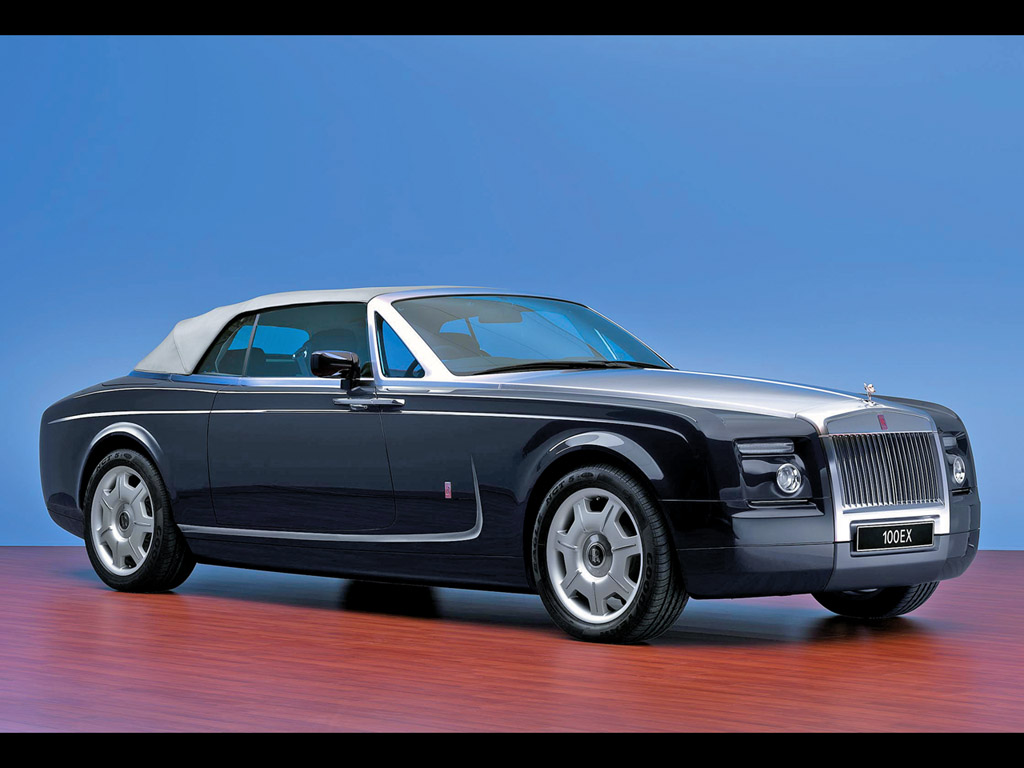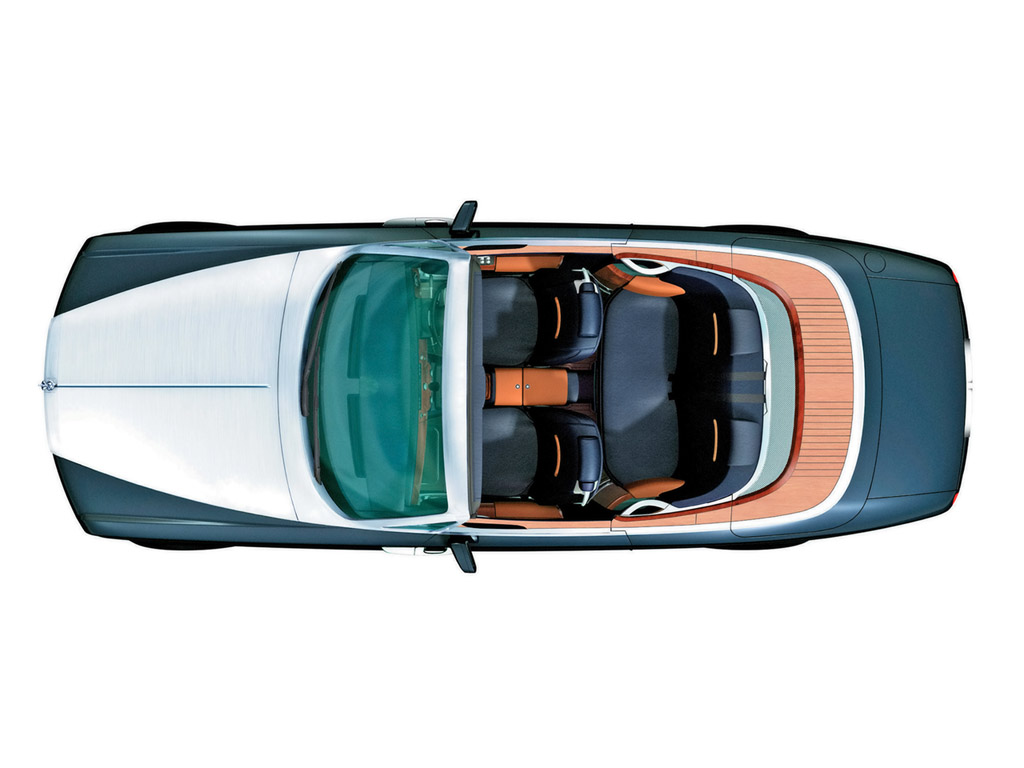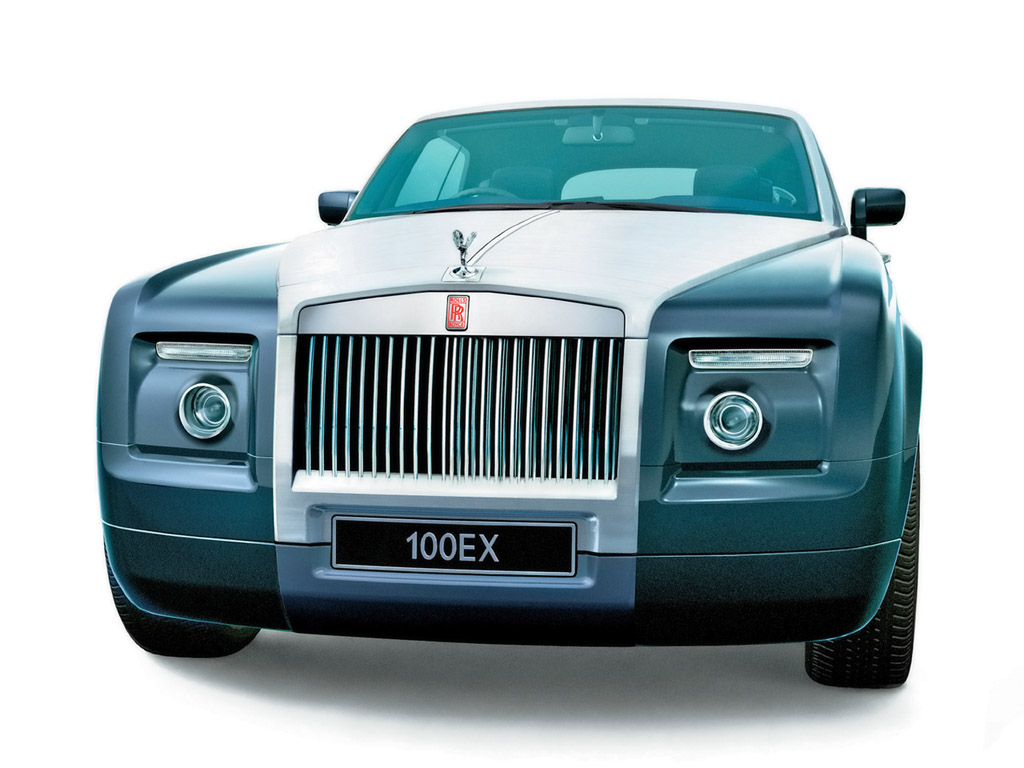2004 Rolls-Royce 100EX Centenary Concept
Design approach
The design team that shaped the new
Experimental Car was based in Southern California, at BMW Group's
studio, Designworks, an entirely natural setting for a luxurious
convertible. Here research was conducted into the Rolls-Royce design
language specific to open-top motoring.
"The historical models proved to be truly inspiring," said Ian Cameron,
Chief Designer for Rolls-Royce. "However, our search was for a design
route which combined the brand's wonderful heritage with a cutting-edge
21st century character."
A number of designs were proposed with the ultimate choices progressing
to the clay stage. After final selection, the build process began, this
time at BMW's specialist design and build facilities in Munich.
Shorter than the Phantom by 165 mm (6.5 in) and 71 mm (3 in) lower, the
100EX has a graceful side profile with a characteristic dynamic rise in
the waistline over the rear wheels and lines that sweep upwards towards
the front of the motor car.
"We intended the silhouette to express the performance potential, yet
reflect the effortless composure typical of Rolls-Royce design rather
than the aggressive, forward-wedged stance of most modern performance
cars," explained Exterior Designer, Marek Djordjevic. "Visually we
wanted to build on the Rolls-Royce tradition of 'waftability', the sense
that 100EX has the power to whisk its passengers swiftly to maximum
speed in a truly relaxed manner."
To emphasise the bodylines, a polished aluminium waist rail surrounds
the passenger compartment. Hand crafted, bleached teak decking has been
chosen to feature both inside and outside the car, forming part of a
strong maritime theme that runs throughout. On the exterior it forms a
tonneau cover for the folded hood and features as an inlay in the
polished aluminium door cappings. "The overall impression is intended to
be of an elegant motor yacht at speed", adds Djordjevic.
At the front, a solid silver Spirit of Ecstasy sits on a progressively
rakish version of the traditional Rolls-Royce grille, blending into the
dramatic bonnet which has been milled from a single aluminium block and
brushed to a high sheen. The windscreen surround and A-pillar,
triangulated for exceptional strength, is also machined from solid
aluminium.
The two coach doors of 100EX demonstrate the marriage of form and
function throughout the car. They are large enough to allow exceptional
access for rear-seat passengers, hinged at the rear in the style of many
exceptional pre-war touring cars and like the rear doors of the new
Phantom.
The tailored soft top is made from an advanced material that
incorporates woven wire strands offering strength and all weather
protection. The inside of the hood is lined with a wool/cashmere blend
fabric. Painstaking design of the folding mechanism means the hood can
be concealed in an extremely small storage area, keeping intrusion into
the luggage space to a minimum.
The rear of the motor car tapers in a boat-tail style and the
'countryman' boot lid is split to give a drop-down lower tailgate. Teak
decking extends across the boot floor, providing a table-like surface.
The 100EX is finished in unique Dark Curzon with 21-inch wheels finished
in Meteor Silver.
Interior design
Interior Designer Charles Coldham
explains, "We drew from the design of contemporary and classic yachts.
The result is a thoroughly modern interior with an unmistakable nautical
influence."
The chosen interior wood veneer is figured mahogany. Upholstery and trim
are in rich Dark Curzon leather, while the flooring features the same
bleached teak decking as the tonneau cover for the folded hood.
Specially-designed front seats are included, which are ultra-supportive
but slender, allowing good legroom for rear passengers. The rear seat
itself, while more intimate than that in the Phantom, is extremely
accommodating for two people, with generous space devoted to passenger
comfort, helped by the neat and space-efficient folding roof mechanism.
The team wanted to create a motor car that gave a 'shared experience',
not something that was solely driver focused. "The cabin of the 100EX is
as much a social environment as the new Rolls-Royce Phantom, but rather
than shutting out the elements, they are embraced", explains Coldham.
Engineering
As an experimental car, the 100EX is
developed to a far higher level of engineering than a typical concept
car. The body structure is a development of the new Phantom's aluminium
space-frame, adapted to the different proportions of the 100EX, which is
similar in width to the Phantom, but 165 mm (6.5 in) shorter and 71 mm
(3 in) lower. The wheelbase is 100 mm (4 in) shorter.
The structure gives the 100EX immense strength and rigidity, something
which is clearly vital for an open-top motor car. It also allows for
coach doors to be selected, which are integral to the design of the
motor car and offer the practical benefit of easing entry and exit. The
polished aluminium windscreen surround, with its triangulated A-pillar,
is effectively an exposed part of the space-frame structure, which
provides excellent roll-over protection.
Suspension and steering geometry are shared with the new Phantom: double
wishbone front and multi-link rear axles, with air springs, and rack and
pinion steering. Wheels are finished in Meteor Silver, with a 21-inch
diameter, and shod with 255/50 tyres at the front and 285/45 at the
rear.
100EX is powered by a 9-litre V16, 64-valve engine. Natural aspiration
was chosen over turbo or supercharging to give the instant, yet
perfectly smooth style of pick-up which has so impressed in the Phantom.
Drive is delivered through a six-speed automatic gearbox.
EX cars
Experimental manufacture of motor cars
and engines has long been a Rolls-Royce tradition. In 1919 the 1EX was
produced, based on a Silver Ghost chassis. It was the first in a long
line of EX cars that spanned almost 40 years, ending with the 45EX in
1958.
It was the larger cars, like the Silver Ghost and the Phantom, which
were given the 'EX' denomination while the smaller experimental models
were given the letter 'G', standing for Goshawk.
Many notable EX motor cars were made. These include 15, 16 and 17EX,
which were based on the Phantom chassis and, in 1927, given to
coachbuilders Hooper, Barker and Jarvis, respectively, in a competitive
quest to produce a lightweight Phantom sports model.
In 1930 Henry Royce began a project to develop more powerful engines
with even greater refinement. He contemplated building a 16 cylinder
engine, but settled on V12 configuration, as being half way between a
six and 16 cylinder engine which, at the time, he considered the two
ends of the possible spectrum for Rolls-Royce motor car application. Up
to this point the Phantom I and II were powered by straight six cylinder
engines.
It is with these important cars in mind that Rolls-Royce Motor Cars has
created a new 'EX' to represent the pinnacle of engineering and
coach-building beauty for the 21st century. It is possible that in the
future, as was the case the original EX motor cars, elements of the
technology featured on the 100EX could be developed for new Rolls-Royce
Motor Cars projects.
Throughout 2004 there is a full calendar of events in place to mark the
centenary of Rolls-Royce, and the 100EX will appear at many of these as
part of the year long celebrations.
Technical specifications:
No. of doors/seats 2/4
Vehicle length 5669 mm
Vehicle width 1990 mm
Vehicle height, unladen1561 mm
Wheelbase 3470 mm
Fuel tank capacity 80 ltr
Engine 9 ltr naturally aspirated V16, 64-valve
Transmission type 6 speed automatic
Steering type Rack and pinion, speed-sensitive
Variable-rate power assistance
Tyre size Front 255/50/R21ins rear 285/45/R21ins
Wheel size Front 8 1/2J R21 ins rear 9 1/2J R21 ins



